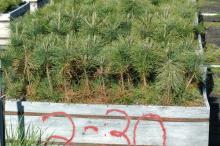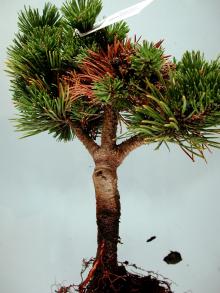Cause The fungus-like organisms Phytophthora cinnamomi and P. citricola have been found by the OSU Plant Clinic. P. cactorum has been isolated from western white pine seed trees in northern Idaho. Root rot is a problem when trees are planted in containers or planted in areas with poor drainage or where flooding occurs. It is mainly a problem in nurseries that use overhead irrigation during the growing season. Can also be a problem where trees are planted for seed production. The pathogens can infect roots under water-logged soil conditions.
Watering shore pines in lawn settings is hard on trees as they are adapted to the dry summer/fall conditions of the PNW. Watering can increase root rot diseases caused by Phytophthora sp. and Armillaria sp. mugo pines (P. mugo) grown in ornamental container nurseries are often susceptible to this disease. Seedlings of lodgepole pine (P. contorta) and poderosa pine (P. ponderosa) are considered highly tolerant while sugar pine (P. lambertiana) and western white pine (P. monticola) and considered tolerant when challenge inoculated with 5 species that did not include P. cinnamomi.
Symptoms These organisms attack the roots, which rot and die. The infection moves up into the root crown, where the cambium (soft inner bark) turns reddish brown instead of the normal greenish white. Older trees may develop cankers on the trunk, possibly accompanied by split bark and oozing pitch. Lower branches wilt, turn brown, and die back. Younger trees often die outright when infected. Mature trees, once infected, may show wilting, branch dieback, or other signs of inhibited water and nutrient uptake.
Cultural control
- Avoid soil compaction, which reduces drainage. Construction, heavy foot traffic, or machinery can cause soil compaction.
- Improve soil drainage by incorporating organic material or using raised beds.
- Place containers on gravel beds (4 inches or more deep) to allow drainage. Do not place containers on poly sheets; they can prevent containers from draining into soil and allow contaminated drainage water to spread from the base of one container to another.
- Avoid reusing pots from a previous crop for propagation. If pots must be reused then wash off all debris and soak in a sanitizing solution or treat with aerated steam for 30 min.
- Prevent disease by planting only pathogen-free materials in uninfected soil.
- Remove and destroy all infected plants and plant debris.
Chemical control May depend on the tree species involved; see label. For resistance management, rotate fungicides that have a different mode of action.
- Aliette at 2.5 to 5 lb/100 gal water for conifers in nurseries. Do not use with adjuvants. Group P7 fungicide. 24-hr reentry.
- Areca at 2.5 to 5 lb/100 gal water as a foliar application for conifers in nurseries. Group P7 fungicide. 12-hr reentry.
- Banrot 40 WP at 6 to 12 oz/100 gal water. For use in commercial greenhouses. Group 1 + 14 fungicide. 12-hr reentry.
- Fosphite at 1 to 2 quarts/100 gal water. Do not use copper products within 20 days of treatment and do not use spray adjuvants. Registered for conifers in commercial nurseries, plantations, forests, landscapes, and parks including Christmas trees. Group P7 fungicide. 4-hr reentry.
- Mefenoxam 2 AQ at 0.98 to 1.96 fl oz/100 gal water as a soil drench or at 1.23 to 2.45 fl oz/1,000 sq ft followed by at least 0.5 inch rain or irrigation. Registered for conifers in nurseries and plantations including Christmas trees. Group 4 fungicide. No restrictions on reentry when used as a soil drench or media incorporation.
- MetaStar 2E at 1 to 4 fl oz/100 gal water as a drench. Registered for conifers in nurseries and plantations including Christmas trees. Group 4 fungicide. No restrictions on reentry when used as a soil drench or media incorporation.
- Monterey Garden Phos at 16 fl oz in 16 fl oz water plus 1 oz Pentra-Bark as a basal trunk spray. Also labeled for injection, see label for details. Can be used in landscape sites. Group P7 fungicide. H
- OxiPhos at 1.3 to 4 quarts/100 gal water as a foliar spray. Registered for conifers grown in field or commercial greenhouses. Group P7 fungicide. 4-hr reentry.
- Phospho-Jet at 1 to 2 qt/100 gal water as a soil drench. Group P7 fungicide. 4-hr reentry.
- Rampart at 1 to 2 quarts/100 gal water/A. Can also be trunk injected. Registered for conifers in commercial nurseries, plantations, forests, landscapes, and parks including Christmas trees. Group P7 fungicide. 4-hr reentry.
- Subdue MAXX at 1 to 2 fl oz/100 gal water. Use 1 pint solution/sq ft. Registered for conifers in nurseries and plantations including Christmas trees. Group 4 fungicide. 48-hr reentry. No restrictions on reentry when used as a soil drench.
- Terrazole 35 WP at 3.5 to 10 oz/100 gal water. For use in commercial nurseries and greenhouses. Group 14 fungicide. 12-hr reentry.
Reference Campbell, S.J. and Hamm, P.B. 1989. Susceptibility of Pacific Northwest conifers to phytophthora root rot. Tree Planters' Notes 40:15-18.



